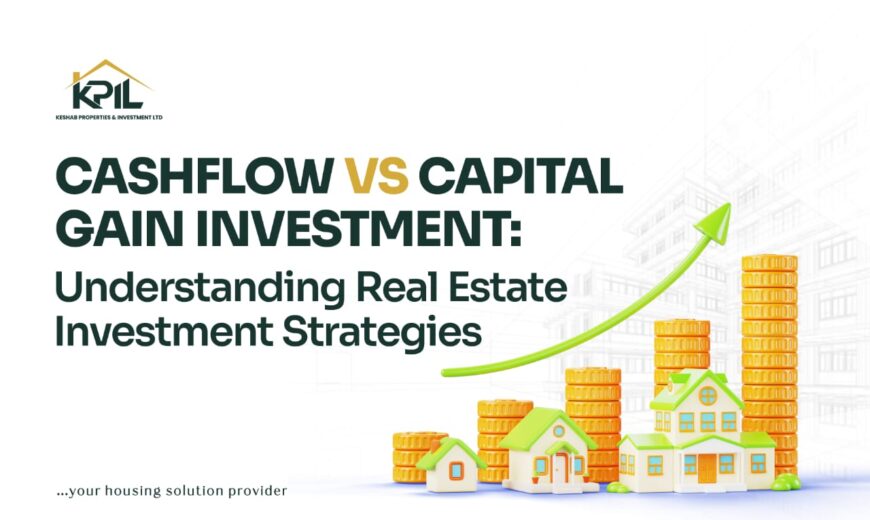
When it comes to real estate investing, there are two key ways to generate wealth: cashflow and capital gains. These strategies offer distinct advantages, depending on your financial goals and how long you’re willing to hold onto an asset. In this article, we’ll explore what cashflow and capital gains are, how they apply to real estate, and how to choose the best strategy for your investment portfolio.
What is Cashflow in Real Estate?
Cashflow in real estate refers to the ongoing income generated from a property. After deducting expenses like mortgage payments, property management fees, and maintenance costs, the remaining profit is your cashflow. This steady stream of income makes cashflow investments attractive for investors seeking passive income.
Examples of Cashflow Real Estate Investments:
- Rental Properties: You purchase a rental property and collect monthly rent from tenants, covering your expenses and generating profit.
- Commercial Real Estate: Office spaces, retail buildings, or industrial properties rented out to businesses can also provide stable, long-term income.
- Vacation Rentals (Short-Term): Platforms like Airbnb have made short-term rentals a lucrative cashflow option for property owners.
The goal of cashflow investing is to have more money coming in each month than going out in expenses. Over time, this passive income can either supplement your primary income or be reinvested into more properties.
What is Capital Gain in Real Estate?
Capital gain is the profit you make when you sell a property for more than its original purchase price. Unlike cashflow, which provides ongoing income, capital gains are realized when the property appreciates in value and is sold. This strategy typically takes a longer-term approach, relying on market appreciation.
Examples of Capital Gain Real Estate Investments:
- House Flipping: You buy a property, renovate it, and sell it for a higher price within a short period.
- Land Development: You purchase undeveloped land and sell it after developing or when it increases in value due to location growth.
- Long-Term Property Appreciation: Hold onto a property for several years as its value increases due to factors like market demand, inflation, or neighborhood upgrades.
- Capital Gain: Investors focus on buying low and selling high. Timing the market and knowing when to sell is key to making significant profits.
The Differences Between Cashflow and Capital Gains in Real Estate
Both cashflow and capital gains in real estate offer ways to grow your wealth, but they work in very different ways.
- Income vs. One-Time Profit: Cashflow provides consistent, recurring income, while capital gains come from a one-time sale of the property.
- Risk Levels: Cashflow investments tend to be less risky because they rely on rental income rather than market appreciation. Capital gains are more speculative and dependent on market conditions.
- Investment Horizon: Cashflow investors usually hold properties for longer periods, benefiting from monthly rent. Capital gain investors may focus on short-term flips or long-term appreciation.
- Taxation: Cashflow income is taxed as regular income, whereas capital gains may qualify for lower tax rates if held long-term.
Pros of Cashflow Real Estate Investments
- Consistent Monthly Income: Cashflow properties offer a steady income stream, which can be reinvested or used to cover living expenses.
- Less Dependent on Market Conditions: Even during market downturns, a well-maintained rental property can continue generating income.
- Scalability: As your portfolio grows, your cashflow increases, creating a cycle where rental income helps fund more property investments.
Cons of Cashflow Real Estate Investments
- Active Management Required: Owning rental properties often involves managing tenants, handling repairs, and dealing with day-to-day operations.
- Slower Wealth Growth: Cashflow doesn’t offer the same potential for rapid wealth accumulation as capital gain strategies. It’s more about building wealth steadily over time.
- Higher Taxes on Rental Income: Cashflow is taxed at regular income rates, which can reduce your overall earnings.
Pros of Capital Gain Real Estate Investments
- Potential for Large Profits: If timed correctly, selling a property at the right moment can result in significant returns.
- Lower Tax Rates for Long-Term Gains: Real estate held for over a year benefits from lower long-term capital gains tax rates.
- Hands-Off Approach: Unlike cashflow properties, capital gain investments don’t require active property management (unless flipping), making them more passive once purchased.
Cons of Capital Gain Real Estate Investments
- Market Risk: Capital gains rely heavily on market conditions. If property values decrease, you may end up selling at a loss.
- No Regular Income: You won’t receive any monthly income, which makes it harder to sustain without other sources of cashflow.
- Timing Can Be Tricky: Knowing when to sell is crucial to capital gain investing, and poor timing can result in missed profits.
How to Choose Between Cashflow and Capital Gain Investments in Real Estate
When deciding between cashflow and capital gain strategies in real estate, consider these factors:
1. Your Financial Goals
If your goal is to generate immediate, reliable income, cashflow investments like rental properties are your best option. They offer a predictable monthly revenue stream. If you’re focused on long-term wealth accumulation and can wait for market appreciation, capital gains from property sales may be more suitable.
2. Risk Tolerance
Cashflow is ideal for risk-averse investors who prefer a steady, low-risk approach. Rental income is relatively predictable, especially in stable markets. Capital gains appeal to higher-risk investors willing to bet on market trends and property appreciation for bigger payoffs.
3. Investment Timeline
For a short-term strategy, such as flipping houses or developing land, capital gain investments can yield faster returns if the market conditions are right. If you’re in it for the long haul, rental properties offer a slow but steady increase in wealth through both income and gradual property appreciation.
4. Diversification
You don’t have to pick one over the other. Many real estate investors diversify their portfolios by investing in both cashflow and capital gain properties. This way, they enjoy both consistent income and the potential for significant long-term profits.
Conclusion
Both cashflow and capital gain strategies in real estate have their own benefits and challenges. Cashflow properties provide consistent monthly income, making them ideal for investors looking for steady cash in-hand, while capital gain investments offer the potential for larger payouts in the long run, appealing to those willing to wait and navigate market fluctuations.
Ultimately, the best strategy depends on your financial goals, risk tolerance, and how long you’re willing to hold onto your investments. Whether you aim to grow your portfolio through regular rental income or by flipping properties for a profit, understanding the strengths and weaknesses of each approach will help you make better investment decisions in the real estate market.
Send us an email for inquiries or chat with us on WhatsApp.
Suggested Post: The basic need for human existence is real estate



